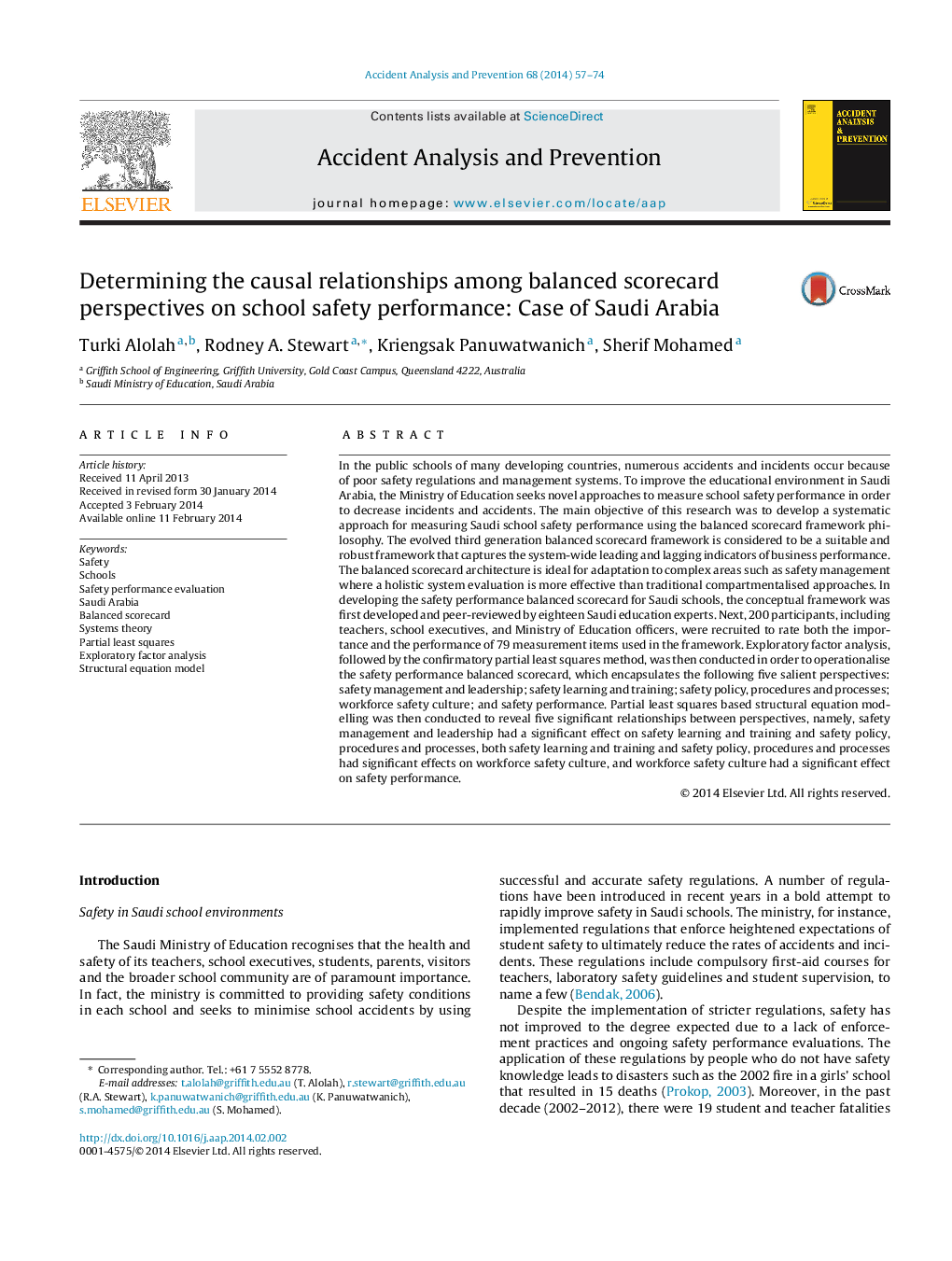| کد مقاله | کد نشریه | سال انتشار | مقاله انگلیسی | نسخه تمام متن |
|---|---|---|---|---|
| 6965946 | 1452929 | 2014 | 18 صفحه PDF | دانلود رایگان |
عنوان انگلیسی مقاله ISI
Determining the causal relationships among balanced scorecard perspectives on school safety performance: Case of Saudi Arabia
ترجمه فارسی عنوان
تعیین روابط علی بین دیدگاه های کارت امتیازی متوازن بر عملکرد ایمنی مدارس: مورد عربستان سعودی
دانلود مقاله + سفارش ترجمه
دانلود مقاله ISI انگلیسی
رایگان برای ایرانیان
کلمات کلیدی
ایمنی، مدارس، ارزیابی عملکرد ایمنی، عربستان سعودی، کارت امتیازی متوازن، نظریه سیستم، حداقل مربعات جزئی، تجزیه و تحلیل عامل اکتشافی، مدل معادلات ساختاری،
Safety performance evaluationSafety - ایمنیSystems theory - تئوری سیستمExploratory Factor Analysis - تجزیه و تحلیل فاکتور اکتشافیPartial least squares - حداقل مربعات جزئی Saudi Arabia - عربستان سعودیSchools - مدارسStructural equation model - مدل معادلات ساختاریBalanced Scorecard - کارت امتیازی متوازن
ترجمه چکیده
در مدارس دولتی بسیاری از کشورهای در حال توسعه، حوادث و حوادث متعدد به دلیل مقررات ایمنی ضعیف و سیستم های مدیریتی رخ می دهد. برای بهبود محیط آموزشی در عربستان سعودی، وزارت آموزش و پرورش به دنبال روش های جدید برای اندازه گیری عملکرد ایمنی مدارس برای کاهش حوادث و حوادث است. هدف اصلی این پژوهش، ایجاد رویکرد سیستماتیک برای اندازه گیری عملکرد ایمنی مدارس سعودی با استفاده از فلسفه چارچوب متوازن متوازن بود. چارچوب کارت امتیازی متوازن نسل سوم توسعه یافته به عنوان یک چارچوب مناسب و قوی محسوب می شود که نشان دهنده شاخص های پیشرو و عقب مانده سیستم در عملکرد کسب و کار است. معماری کارت امتیازی متوازن ایده آل برای انطباق با حوزه های پیچیده مانند مدیریت ایمنی است که در آن یک ارزیابی سیستم جامع تر از روش های متمایز سنتی موثر است. در توسعه کارت امتیازی متوازن ایمنی برای مدارس سعودی، چارچوب مفهومی ابتدا توسط 18 کارشناس آموزش عربی عرب مورد بررسی قرار گرفت. سپس 200 نفر شرکت کننده، از جمله معلمان، مدیران مدرسه و مامورین وزارت آموزش و پرورش، برای ارزیابی اهمیت و عملکرد 79 مورد اندازه گیری مورد استفاده در چارچوب استخدام شدند. تجزیه و تحلیل فاکتور اکتشافی، و سپس روش حداقل مربعات جزئی تضعیف، به منظور بهره برداری از کارت امتیازی متوازن ایمنی عملکرد، که شامل پنج چشم انداز برجسته: مدیریت ایمنی و رهبری؛ یادگیری ایمنی و آموزش؛ سیاست ایمنی، رویه ها و فرآیندها؛ فرهنگ ایمنی نیروی کار؛ و عملکرد ایمنی. سپس مدلسازی معادلات ساختاری مبتنی بر حداقل مربعات تقریبا پنج روابط مهم بین دیدگاهها، یعنی مدیریت ایمنی و رهبری، تأثیر قابل توجهی بر یادگیری ایمنی و آموزش، سیاست ایمنی، رویه ها و فرایندها، آموزش های ایمنی و آموزش و سیاست ایمنی، رویه ها و فرایندها تأثیر قابل توجهی بر فرهنگ ایمنی نیروی کار داشتند و فرهنگ ایمنی نیروی کار بر عملکرد ایمنی اثر معنی داری داشت.
موضوعات مرتبط
مهندسی و علوم پایه
مهندسی شیمی
بهداشت و امنیت شیمی
چکیده انگلیسی
In the public schools of many developing countries, numerous accidents and incidents occur because of poor safety regulations and management systems. To improve the educational environment in Saudi Arabia, the Ministry of Education seeks novel approaches to measure school safety performance in order to decrease incidents and accidents. The main objective of this research was to develop a systematic approach for measuring Saudi school safety performance using the balanced scorecard framework philosophy. The evolved third generation balanced scorecard framework is considered to be a suitable and robust framework that captures the system-wide leading and lagging indicators of business performance. The balanced scorecard architecture is ideal for adaptation to complex areas such as safety management where a holistic system evaluation is more effective than traditional compartmentalised approaches. In developing the safety performance balanced scorecard for Saudi schools, the conceptual framework was first developed and peer-reviewed by eighteen Saudi education experts. Next, 200 participants, including teachers, school executives, and Ministry of Education officers, were recruited to rate both the importance and the performance of 79 measurement items used in the framework. Exploratory factor analysis, followed by the confirmatory partial least squares method, was then conducted in order to operationalise the safety performance balanced scorecard, which encapsulates the following five salient perspectives: safety management and leadership; safety learning and training; safety policy, procedures and processes; workforce safety culture; and safety performance. Partial least squares based structural equation modelling was then conducted to reveal five significant relationships between perspectives, namely, safety management and leadership had a significant effect on safety learning and training and safety policy, procedures and processes, both safety learning and training and safety policy, procedures and processes had significant effects on workforce safety culture, and workforce safety culture had a significant effect on safety performance.
ناشر
Database: Elsevier - ScienceDirect (ساینس دایرکت)
Journal: Accident Analysis & Prevention - Volume 68, July 2014, Pages 57-74
Journal: Accident Analysis & Prevention - Volume 68, July 2014, Pages 57-74
نویسندگان
Turki Alolah, Rodney A. Stewart, Kriengsak Panuwatwanich, Sherif Mohamed,
